http://www.chemistrymag.org/cji/2006/083020ne.htm |
Mar. 12, 2006 Vol.8 No.3 P.20 Copyright |
Wang Yong, Gao Jungang, Hou Guixiang
(Department of Polymer Science, College of Chemistry and Environmental Science, Hebei
University, Baoding 071002, China)
Received Jan. 18, 2006; Supported by the Natural Science Foundation of Hebei Province (B2005000108).
Abstract The unsaturated liquid crystalline (LC) compound of p-phenylene di {4- [2- (allyloxy) ethoxy] benzoate} (p-PAEB) and homopolymer poly(p-PAEB) were synthesized. The liquid crystalline behavior and thermal properties of p-PAEB and poly (p-PAEB) have been studied by polarizing optical microscopic (POM), differential scanning calorimetry (DSC), X-ray diffractometer (XRD), torsional braid analysis (TBA). The results of XRD and POM showed that p-PAEB is smectic texture and the poly(p-PAEB) are nematic texture. The dynamic mechanical properties and glass transition temperature Tg of liquid crystalline polymers network (LCP) were investigated with TBA.Keywords Unsaturated Liquid crystalline monomer; polymerization; Morphology; Thermal properties
1. INTRODUCTION
The effect of monomer organization on the
polymerization and properties of polymers has been investigated from both scientific and
industrial points of view. One of the typical monomer organizations is based on the
thermotropic liquid crystalline (LC) systems. Thermotropic LC has become important in the
field of advanced materials, such as used in electronic devices and high-strength fibers.
Recently many studies have been focused on polymer networks with an anisotropic molecular
orientation by polymerization of liquid crystalline monomers in a unidirectional
orientation [1-3]. The macroscopically oriented polymer networks
were found to exhibit anisotropic mechanical and optical properties. In particular,
densely cross-linked polymer network, which were prepared by bi- or polyfunctional LC
monomers, showed excellent transparency and stable anisotropic molecular orientation [2].
The lightly cross-linked polymer networks can be shown a reversible phase transition
between a liquid-crystalline phase and an isotropic phase [4].
LC monomers having polymerizable groups such as acrylate, methacrylate,
vinyl ether, epoxide, and diene derivatives were used in the pursuit [4-6]. In
this paper, the unsaturated LC monomer p-phenylene di {4- [2- (allyloxy) ethoxy] benzoate}
(p-PAEB) was synthesized, the polymerization of p-PAEB was investigated. The morphological
structure and thermal properties of p-PAEB and poly (p-PAEB) were examined.
2. EXPERIMENTAL
2.1 Material
Hydroquinone, sulfoxide chloride, allyl 2-hydroxyethyl ether, 4-hydroxy ethyl
benzoate, dimethylformamide (DMF) and tetrahydrofuran (THF) were all of analytically pure
grades and supplied by the Beijing Chemical Reagent Co. China.
2.2 Synthesis of p-PAEB
The liquid-crystalline monomer p-PAEB was synthesized according to the literature [7].
The molecular structure of p-PAEB is as follows:

2.3 Polymerization
The homopolymer was synthesized as the following: 5.18g p-PAEB (0.01mol) and
50ml THF were added into a 100ml four-necked glass flask. The reaction was carried out
under a nitrogen atmosphere, after 1%AIBN (mol of monomer) was added, the mixture was
heated under reflux for 48h.The formed polymers were isolated by precipitating into a
large amount of methanol and purified, then vacuum dried overnight at 50°C.
2.4 Characterization of monomer and polymer
The structure of p-PAEB was examined by means of FTIR (Bio-Rad FTS-40, USA) and 1H-NMR
(Bruker 400k, Switzerland); FTIR spectra of LC monomer and homopolymer were obtained by
KBr method. Thermal phase transition behavior was examined by means of differential
scanning calorimetry (DSC, Diamond, Perkin-Elmer Co.) and polarizing optical microscopic
observation (POM, XPT-7, Nanjing, China). Scanning rate of DSC measurements was 10°C/min, and the peak temperatures
obtained were taken as the phase transition temperatures.
X-ray diffraction patterns were recorded by monitoring the diffraction
angle 2q from 1-30° using
a Savitzkey-Golay's Y-2000 X-ray diffractometer. The diffractometer was
equipped with a CuKa (l=0.1542nm) radiation, produced under
the conditions of 40 kV and 100 mA.
Torsional braid analysis (TBA) were performed by using GDP-4 Torsional
Braid Analyzer (Jilin Univ.China) at the heating rate of 2°C/min from 20-300°C.
3. RESULTS AND DISCUSSION
3.1 NMR and FTIR analysis
Monomer p-PAEB:1H-NMR(DMSO), d[ppm]= 3.76-4.26 (m, 12H, 2-CH2-O-CH2-CH2-);
5.16-5.31 (m, 4H, H2C=CH-); 5.8-5.9(m, 2H, H2C=CH-); 7.36-8.11 (m,
12H, Ar-H). This assignment is in agreement with the structural compositions of the
sample.
The IR spectra of p-PAEB and homopolymer reveal the presence of
characteristic absorptions of components. The absorption peaks at 3073 cm-1 of
p-PAEB can be associated with -C=C- stretching vibration absorption bands, on the other
hand, at 3000-2800 cm-1 (CH2 stretching), 1750 cm-1 (carbonyl
group vibration), 1620-1436 cm-1 (aromatic C=C stretching) are consequences of
the p-PAEB. Especially, a peak of homopolymer at 3073cm-1 becomes much lower
than that of p-PAEB. It indicated that the p-PAEB has been polymerized.
3.2 Optical texture and X-ray diffraction
The textures of liquid-crystalline p-PAEB is shown in Fig.1, As seen from Fig.1 the
liquid-crystalline compound (p-PAEB) under POM reveals fan optical texture of smectic
phase[8], the texture of polymer reveals irregularly nematic schlieren texture[8]
(Fig. 2), which will be clearly identified in the X-ray analysis described.
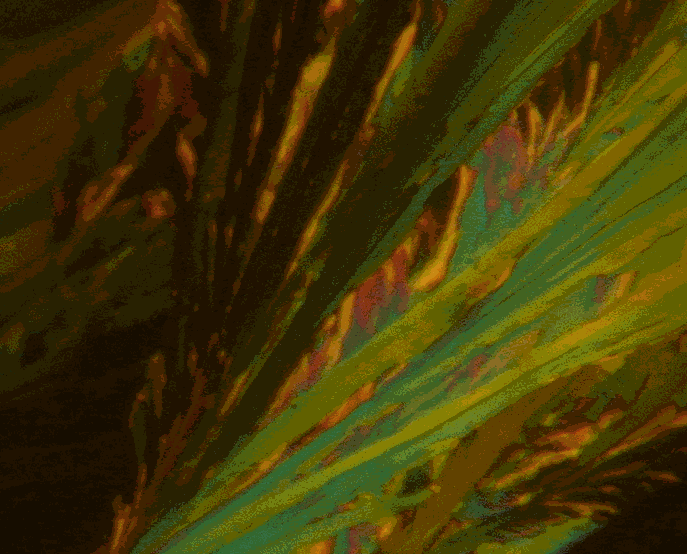 |
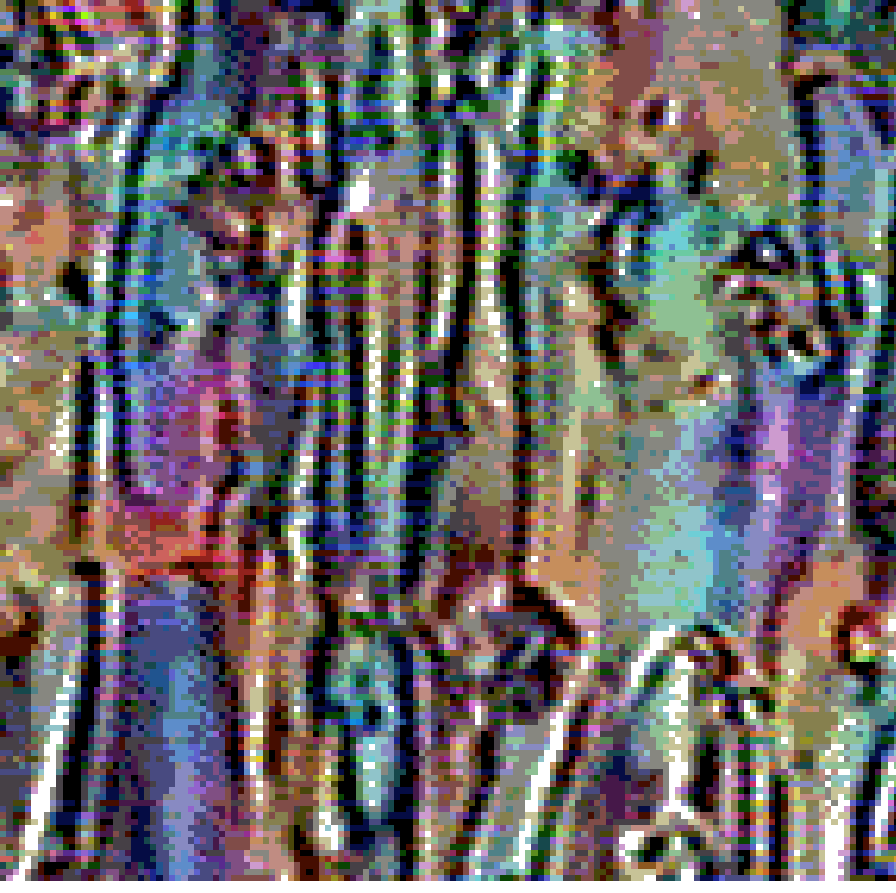 |
| Figure 1 Texture of LC p-PAEB | Figure 2 Texture of polymer |
To obtain more detailed information on the mesophase
structure of the polymer, XRD studies were carried out. The patterns of p-PAEB and
poly(p-PAEB) are shown in Fig.3. The diffraction pattern of pure p-PAEB exhibited a high
degree of crystallinity and attributed to a smectic mesophase. It was exhibited two narrow
peaks in the wide-angle region (2q =20o), in addition to one sharp peak in the
small-angle region (2q =5o). On the other hand, the X-ray patterns of poly
(p-PAEB) showed smaller peak in the small-angle region and the two narrow peaks in the
wide-angle region (2q =20o). These are shown that the degree of crystallinity
of poly (p-PAEB) is lower than that of p-PAEB, and showing that the polymerization of
monomer p-PAEB has some restrict for its crystallization.
The small-angle diffraction (2q =5o) corresponds to the Bragg maximum of d=1.7nm
for p-PAEB. The wide-angle diffraction (2q =20o) corresponds to an intermolecular
spacing (or the diffuse diffraction) of 0.446nm in the layer. The results suggest
that the layer spacings correspond to single-layer packing.
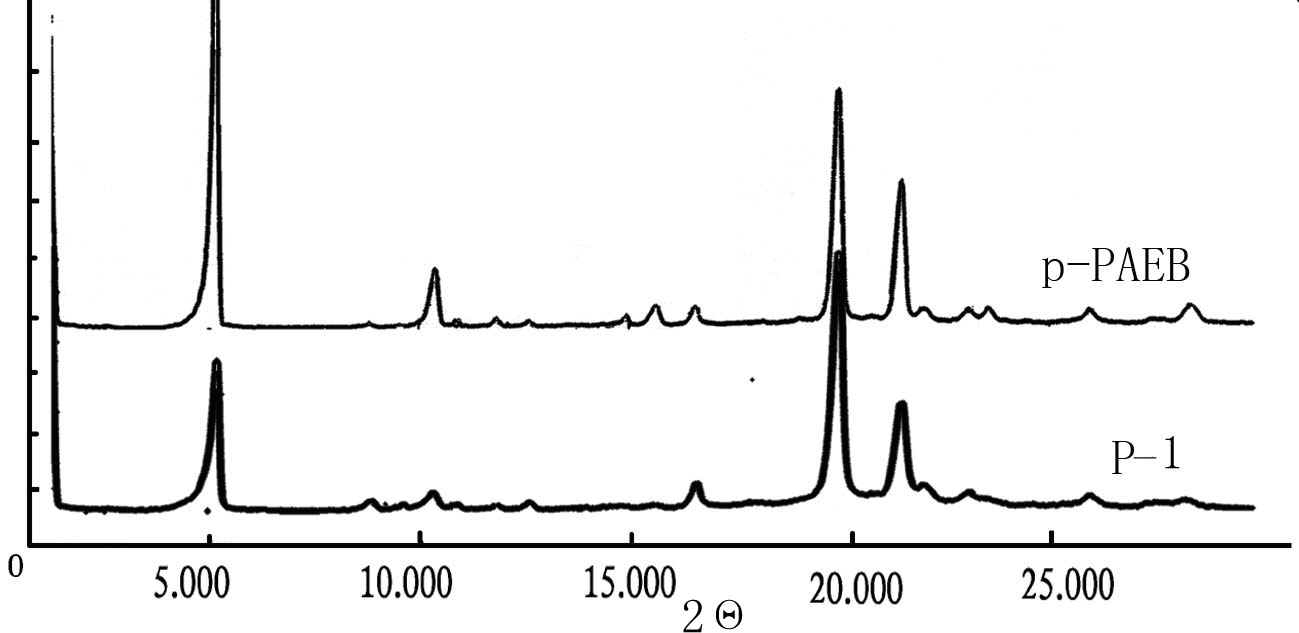
Figuer 3 WAXD curves of
p-PAEB and P-1 (polymer of p-PAEB)
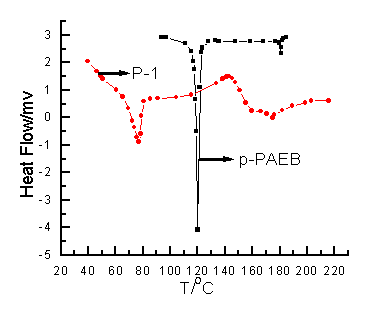
Figure 4 DSC thermograms of monomer p-PAEB and homopolymer
3.3 Mesomorphic properties of p-PAEB and
homopolymer
It was found that the LC polymers change to liquid crystal phase when heated to their Tm.
The broken focal-conics texture can be observed in the range of melting temperatures (Tm)
to isotropization temperatures (Ti, clearing point).
Fig. 4 shows the DSC
thermograms obtained for p-PAEB and its homopolymer. As seen from Fig. 4, in heating DSC
scan of p-PAEB, two peaks are observed at Tm=120.5°C, Ti=191.5°C. The mesomorphic
state of polymer occurs in the range 77-170°C. The
temperatures of Tm and liquid crystal to isotropic transition Ti
are lower than the monomer and increased broad. This is due to increase length of flexible
chain between the two liquid crystal units after polymerization and the polydispersity of
polymeric product [9,10].
3.4 Mechanical loss and glass
transition temperature Tg
The torsional braid analysis (TBA) was used to determine the mechanical loss and glass
transition temperature Tg of the LC polymer network systems. Generally,
the Tg of a low cross-linking density resin system is related to the
conversion and a soft segment, the conversion depends upon the curing conditions, such as
temperature and time. With these curing conditions varying, the Tg of
the system will be changed, so that Tg has been used directly as a
parameter for conversion of thermosets in the analysis of reaction kinetic models [11].
The TBA spectrum for polymer is shown in Fig. 5, as seen from Fig.5,
the maximum loss peak appears at 114°C which is lower than Tm
(120.5°C). This result
also indicates that the Tg is at about 114°C and macroscopically uniaxial
molecular orientation of LC monomer and LC order-distribution is playing a more important
role in the glass transition.
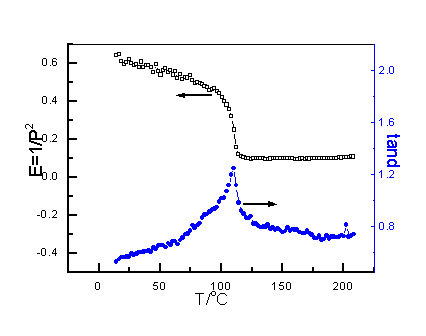
Figure 5 TBA spectrum of
poly(p-PAEB) schlieren texture
4. CONCLUSIONS
The compound of p-PAEB is smectic LC compound, it has a LC temperature range of 120.5
to 191.5°C. The
homopolymer of p-PAEB is nematic schlieren liquid crystalline texture, and the LC
temperature range is 77 to 170°C. The glass transition temperature Tg is about
at 114°C and lower than Tm (120.5°C) of p-PAEB.
REFERENCES
[1] Broer, D.J., Hynderickx, I.Macromolecules, 1990, 23: 2774.
[2] Hikmet, R.A., Lub, J.Prog.Polym.Sci., 1996, 21:1165.
[3] Hoyle, C.E., Watanab, T., Whitehead, J.Macromolecules, 1994, 27: 6581.
[4] Kurihara,S.,Sakamoto,A.,Nonaka,T.Macromolecules, 1999, 32: 3150.
[5] Broer D J, Finkelmann H, Koudo K.Makromol Chem, 1988, 189: 185.
[6]Jaromhi,S.,Kuipers,W.A.G.,Norder,B.,etal.Macromolecules, 1995, 28: 2201.
[7] Jahromi, S., Lub, J., Mol, G. N. Ploymer, 1994, 35: 622.
[8] Zhou Qi-Feng,Wang Xin-Jiu,Liquid Crystal
Polymers,Beijing:Science Press, 1999, 75.
[9] Warran, R.E., Phys.Rew., 1941, 59: 693.
[10] Allock, H.R.and Kim, C., Macromolecules, 1990,23,3881.
[11] Simon, S. L.; Gillham, J. K. J Appl Polym Sci 1993, 47, 461.
p-PAEB液晶聚合物的形态与热性能
王勇, 高俊刚,侯桂香,
(河北大学化学与环境科学学院, 保定, 071002)
摘要 合成了液晶p-PAEB和它的均聚合物,用偏光显微镜、DSC、x-射线衍射仪和扭辩分析仪研究了它们的液晶行为和热性能。结果说明单体是近晶型织构,而均聚合物是向列型纹影织构,聚合物有更宽的液晶温度范围。用TBA测定了聚合物的Tg,
为114℃。
关键词 不饱和液晶单体,聚合,形态,热性能